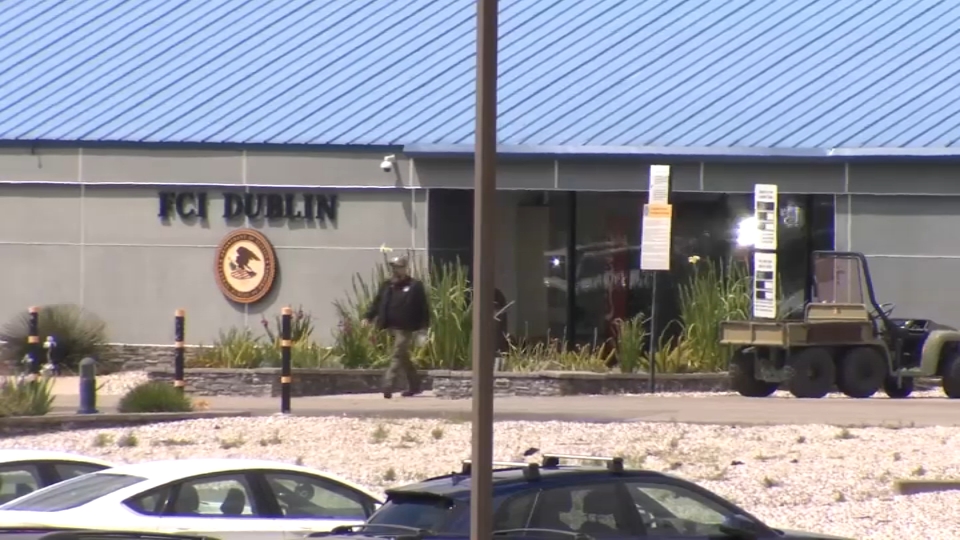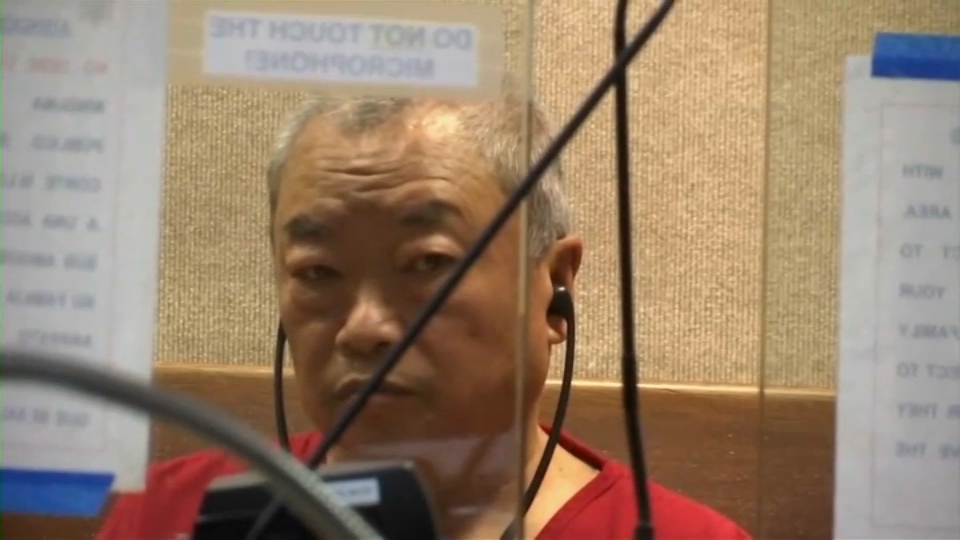Yet another fatal shooting on a freeway in Oakland on Feb. 4, 2022, has many people wondering if the San Francisco Bay Area is seeing a disturbing, violent trend.
Cal Basketball 1970’s legend Gene Ransom was shot and killed on Interstate 880 in Oakland. California’s Highway Patrol has arrested 25-year-old Juan Angel Garcia of San Francisco for that fatal shooting the day after Ransom was found dead in his car.
An analysis by NBC Bay Area of CHP data on freeway shootings shows a disturbing trend.
The statistics show freeway shootings more than doubled between 2019 and the end of 2021. Maps created by NBC Bay Area’s Investigative Unit show hot zones where highest number of shootings occur. Investigators say gang warfare is the leading cause of the spike, as overall homicide rates rise to their highest levels since federal agencies began tracking that data nearly 100 years ago.
Get a weekly recap of the latest San Francisco Bay Area housing news. Sign up for NBC Bay Area’s Housing Deconstructed newsletter.
A single bullet, shot on highway I-580 into a moving vehicle, changed life for Barbara Nguyen and her family. “They didn't just ruin one person's life, they ruined many others,” said Nguyen, after her brother, David Nguyen, was shot and killed as he was driving home to San Francisco from a deputy training program. Nguyen was one month away from graduating and becoming a deputy for the Alameda County Sheriff’s office.
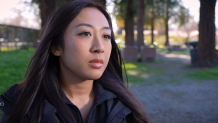
“The situation itself is devastating, but the fact that the perpetrator is still out roaming free, no leads, nothing, it's very disappointing,” said his sister, Barbara. “David deserves justice. And it's not just David either, it's all the other victims. There are a lot of things that need to change. And if they don't, then it's going to continue happening.”
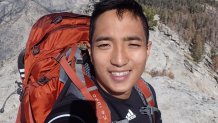
NBC Bay Area’s analysis of the CHP data shows that in the past 3 years, shootings along freeways more than doubled in the Bay Area, rising 117%, from 82 shootings in 2019 to 124 in 2020 and 178 shooting through mid-December 2021.
Bay Area Highway Shootings, 2019-2021
The NBC Bay Area Investigative Unit mapped 378 reported highway shootings that occurred between 2019 and 2021. Larger points indicate reports of death or injury. Approximate shooting locations are based on data from the California Highway Patrol.
Source: California Highway Patrol
Credit: Sean Myers/NBC Bay Area
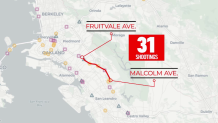
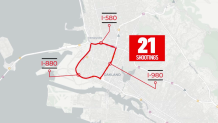
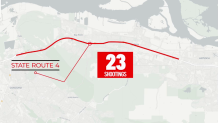
Dr. Philip Cook, Public Policy Professor Emeritus at Duke University, has studied gun violence in American cities since the 1970’s, focusing on the economics of violent crime, their causes and effects.
Local
Dr. Cook points out that while most other crimes dropped nationwide in 2020, homicides spiked. “There’s never been such a large increase as there was between 2019 and 2020,” he said, noting the level of homicides was highest since the federal government began tracking homicides in the 1930s: a 30% increase in the number of people killed. That includes a spike in violent crimes in the Bay Area in cities such as San Francisco and Oakland and surrounding communities.
Cook said several factors may have contributed to the surge in homicides. During the pandemic, courts went virtual, jails emptied out, and social services that work with young men scaled back. Meanwhile, there’s been a steep rise in gun sales and gun carrying.
But Dr. Cook said that only partially explains the large jump in freeway shootings.
Joshua Jackson, Assistant Special Agent in Charge at Alcohol, Tobacco and Firearms, admits that oftentimes it’s hard for investigators to solve these highway shootings. However, Jackson said his agency helps state and local investigators by using all cutting edge high technology tools to help track suspects in freeway shootings down. “You're dealing with a large field of evidence,” said Jackson, “it could be anywhere from a quarter mile to a couple of miles that you're dealing with.” To find that evidence, ATF uses specially trained dogs.
“Canines are critically important in assisting us to do the comprehensive collection that we need to do to get this ballistic evidence put into NIBIN and over to our lab.” NIBIN which stands for National Integrated Ballistic Intelligence Networks, is an ATF run weapons database. It collects millions of pieces of ballistic evidence from crime scenes across the country and helps make matches to other crimes and potential suspects where the same weapons were used.
“We're able to develop DNA of those fired cartridge casings, said Jackson, and while he said he can’t compromise a case by sharing specific information, he confirmed ATF has effectively tracked down freeway shooting suspects by analyzing fired casings.
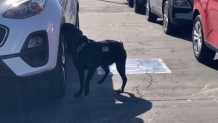
“The biggest thing we want to stress to people is that our freeways are safe. The reality is, if we look at the statistics, you are far, far more likely to be involved in a crash or actually be affected by somebody driving while distracted than be involved in one of these incidents," said Officer Andrew Barclay, Public Information Officer at California Highway Patrol’s Golden Gate Division, which oversees all the Bay Area roadways and is the lead investigative agency on all these shootings.
“In the incidents that we have been able to really break down and look at the causes…our number one is targeted violence or targeted gang violence,” said Barclay.
Officer Barclay said the second biggest cause of these freeway shootings is road rage.
Other law enforcement sources confirmed that gang hits are the main cause of the freeway shootings, and that innocent bystanders are getting caught in the crossfire.
And despite involvement of multiple law enforcement agencies and their resources, the data show these crimes often go unsolved. Sources say it’s because there are few witnesses, a vague crime scene and an easy getaway, and few of these cases are ever solved. Of the 178 highway shootings handled by the CHP in 2021 only 11%, about one in 10, ended with any kind of arrest. The rate was similar in 2019 and 2020.
“These are complex and lengthy investigations,” said Barclay. “We're working in an environment where these crimes occur that are very dynamic.”
The CHP pointed out that in the latest freeway shooting, that of Cal Basketball legend Ransom, a suspect was arrested with 24 hours of the incident.
Several different local law enforcement sources expressed concern to The Investigative Unit that the CHP may not be the best agency to lead shooting investigations, arguing CHP specializes in traffic enforcement and accidents, not violent gunfire and gang warfare.
“One key to solving these crimes is knowing the crime gangs that are working in an area,” said Dr. Cook. “I don't know whether the Highway Patrol has that capacity.”
When asked if the CHP is the right agency to lead these investigations, Officer Barclay said, “Absolutely…we are a statewide law enforcement agency. We have our investigative services unit. They are the trained professionals that are there to investigate these cases.”
One solution to solving this problem may be installing and utilizing more surveillance cameras along freeways. After a spike in highway shootings five years ago, Pittsburg Police installed a freeway security network: some 200 cameras, plus Shot Spotter sound equipment, to help catch shooters and their getaway cars.
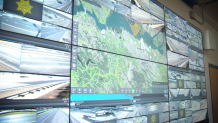
“After we put the system in place in 2016, we saw a drastic reduction in freeway shootings within the city limits for Pittsburgh.” said Police Captain Steve Albanese.
It’s expensive. Pittsburg has already spent more than $3 million on highway cameras, paid for by federal and state grants, and the city of Pittsburg.
But police there say, “it’s 100 percent worth it.”
Dr. Cook points out that downtown Chicago has cameras everywhere. “And I think the local folks welcome them,” he said. “They feel that despite the loss of privacy, that if it helps make those areas safer than they would be, otherwise, it's worth it.”
“Anybody, any one of us driving to work, driving to your family, your friend's house, you can be a victim in one of these shootings that are taking place on our highways and freeways,” said STF Special Agent Jackson.
“Once you lose a loved one…there's nothing that you can do to bring them back for all the money in the world,” said Barbara Nguyen. “The only thing you can do is make sure that it doesn't happen to other people. And that's the change I want to see, I want to see a safer environment for young kids to grow up and feel safe.”

